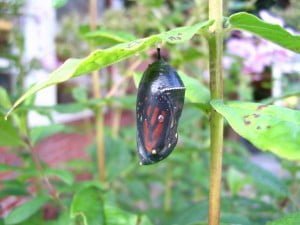Establish garden rules. Just like the classroom, there should be simple and clear expectations for behavior. Work with students to create garden rules everyone can follow. A few examples include: Walk, stay on the pathways, use tools appropriately, keep soil and insects in the garden, share tools and garden resources , and work together. The more children are involved in the creation of these rules, the more they can be held responsible in remembering them.
Create obvious pathways. The garden should be a place for children to explore freely without lots of “nos” and “don’ts.” By creating obviously pathways, you’ll help students to be able to easily understand where they should and should not step.
Use baking flour to guide planting or weeding. When working in large groups of students, it’s helpful to define clear planting and weeding areas ahead of time. By sprinkling baking flour on the plants to weed or places to plant, you can create successful (stress free!) gardening experiences for classes.
Set aside a spot for sand, rock, and soil exploration. Students inevitably finish gardening activities at different times. Having garden areas set aside for exploration provides great back-up activities when working with large groups and encourages self-directed activities in the garden.
Recruit community support/volunteers. Identify potential community partners who can help with the garden or volunteer with your class during garden time. Is there a college or university in your area? Do you have a parent or grandparent in your class who would like to help? It is helpful to have extra hands in the garden, and is also a great way to connect students with their community.
Make a list of volunteer activities. Volunteers can help a class garden in lots of ways. From assisting with or leading weekly garden activities, to helping collect needed materials or maintain a class bed. Brainstorm a list of ways parents and grandparents can get involved and send it home with a sign up form for parents.

Show them how. A picture (or a demonstration) is worth a thousand words. Never tell kids something you could show them.
Establish a routine. Set aside a weekly or daily time when you go out to the garden with your class. Are there daily activities the class can do there? From eating snack to journal writing to documenting temperature or rainfall, the garden offers a space for many classroom activities. Having a regular time when your class goes to the garden also helps other teachers to set times for their class garden times and lets parents know when to keep their child’s new white shoes at home.
Set the stage before you go. Talk with students in the classroom and explain steps of the garden activity before you go out to the garden. If students hear expectations and receive direction ahead of time, their time in the garden will be even more successful.
Involve students in all garden activities. You can get almost any gardening activity done with students, and every gardening task can be linked to a learning experience. Need to weed? Tell students about plant parts and explain why weeding the entire plant, including roots is important. Studying earth materials? Guide students in becoming soil scientists, examine the soil, and then add amendments. Kids will be more engaged and committed to the garden if they choose seeds, make signs, and engage in the garden in multiple ways.
Encourage small successes. Instant gratification helps a lot. Plant radishes or turnips even if you don’t like them-they come up in three or four days and are ready to harvest in just a few weeks. Planting some “starts” along with seeds offer students plants to observe before their seeds sprout.
Use the garden to encourage leadership. Try to add responsibility and ownership to projects. (“Quincy is in charge of the wheelbarrow today.”) Connecting with another class or grade level offers a great opportunity to pair up older kids with younger ones.

Connect the garden with curriculum. From journaling in the garden to reading a book to studying plant life cycles, you can connect the garden with almost any subject you are teaching. Using the garden to teach core curriculum requirements ensures that you’ll incorporate gardening into weekly schedules and it will be a tool for teaching rather than an “extra.” More than anything, connecting the garden with curriculum means that you can create meaningful learning experiences for students.
Let kids get dirty! Getting dirty is an integral part of growing up and a part of gardening. Find ways to make getting dirty okay. Do a dance of stomping and brushing off at the end before you come into the building. Bring hand towels to use to brush dirt off hands before coming inside. Wear gloves, etc.
Be a good model. Your role should be as facilitator, rather than as a leader who imposes direction. Model the behavior and skills you want to see. Get down and plant or weed with the kids. Ask Questions. Show enthusiasm for the garden and don’t be afraid to get your own hands dirty! Doing this won’t be a walk in the park.
Practice Reflection. After an activity, create opportunities to reinforce and build upon what everyone has learned. Talk about what went on, who did what, and who saw what. If you can, have them write things down or draw pictures. If they’re too young, take dictation or create a class story.
Don’t recreate the wheel. Educators have been gardening with children for a long time. Take advantage of other’s experience and resources. Connect with other teachers in your school or community to see what has worked for them.

